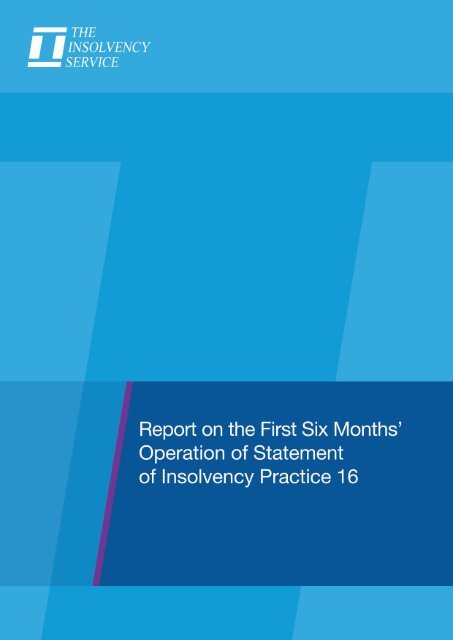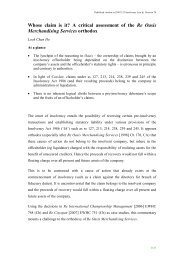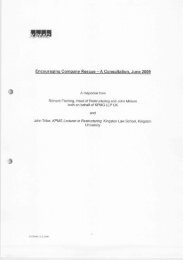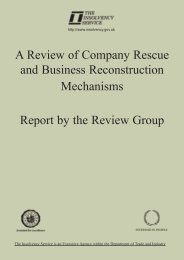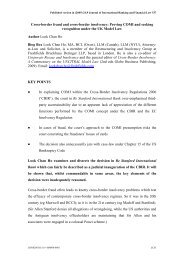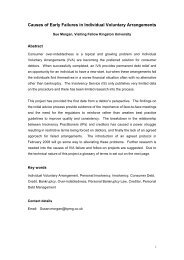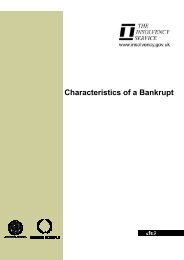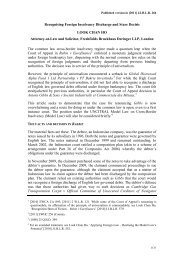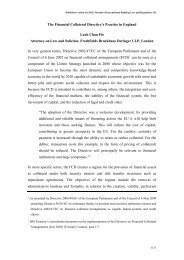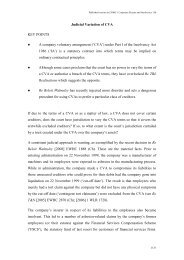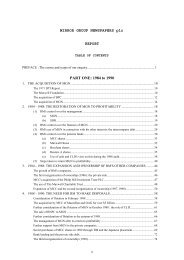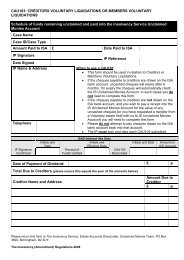Operation of Statement of Insolvency Practice 16 - The Insolvency ...
Operation of Statement of Insolvency Practice 16 - The Insolvency ...
Operation of Statement of Insolvency Practice 16 - The Insolvency ...
- No tags were found...
You also want an ePaper? Increase the reach of your titles
YUMPU automatically turns print PDFs into web optimized ePapers that Google loves.
LOUISIANA TECH UNIVERSITYCollege <strong>of</strong> Engineering and ScienceRecommended Circuit Diagram for RTDYou will use the same circuit for the RTD that you used earlier for thephotoresistor. However, the resistance R 1 and the capacitance shouldbe modified similar to what is shown below. Two capacitors in parallelhave a capacitance equal to the sum <strong>of</strong> the two capacitances (20μF forthe capacitors below).P6R 1 ~ 100ΩExample Calibration ProgramRTD ~ 100Ω 10μF 10μF3
1.0 Executive summaryIn carrying out a review <strong>of</strong> the operation <strong>of</strong> <strong>Statement</strong> <strong>of</strong> <strong>Insolvency</strong> <strong>Practice</strong> <strong>16</strong> (SIP <strong>16</strong>) onpre-packaged sales in administrations, we have examined both the operation <strong>of</strong> the SIP byinsolvency practitioners and the outcomes <strong>of</strong> enforcement procedures in pre-pack cases. <strong>The</strong>decision as to whether a pre-pack is the appropriate course <strong>of</strong> action is a commercial judgementfor the practitioner. <strong>The</strong> purpose <strong>of</strong> the SIP is to ensure that creditors are given sufficientinformation to understand the circumstances surrounding that decision and the reasons why theparticular course <strong>of</strong> action was adopted by the practitioner.<strong>Insolvency</strong> practitioners have been generally positive in their approach to the SIP and its aims,and in the majority <strong>of</strong> cases information has been provided in compliance with its requirements.However, we were disappointed to note that a significant number <strong>of</strong> the reports issued to datefall short <strong>of</strong> full compliance, <strong>of</strong>ten due to a failure to provide sufficient detail. Information relatingto 370 out <strong>of</strong> a total <strong>of</strong> 572 companies in administration was compliant with the disclosurerequirements <strong>of</strong> SIP <strong>16</strong>, representing 65% <strong>of</strong> the total. It should be noted that failure to complywith the SIP does not imply misconduct in the pre-pack sale itself, a lack <strong>of</strong> good faith, or failureto act in the best interests <strong>of</strong> creditors. In many cases, apparent non-compliance may beattributed to early differences in interpreting the requirements <strong>of</strong> the guidance. However, in 17 <strong>of</strong>the cases reviewed the insolvency practitioners’ conduct was such as to warrant it beingreferred to their authorising bodies so that it may be considered from a regulatory anddisciplinary perspective. <strong>The</strong>se referrals involved 29 insolvency practitioners and representaround three percent <strong>of</strong> the cases reviewed.We have discussed our concerns with insolvency practitioners’ authorising bodies, andadditional guidance about the importance <strong>of</strong> complying with both the spirit and letter <strong>of</strong> SIP <strong>16</strong>has been issued to practitioners. Following this clarification we expect compliance to improve.At present, only limited data is available regarding directors’ misconduct in SIP <strong>16</strong> cases, asthere is necessarily a period <strong>of</strong> time between the onset <strong>of</strong> any administration and the conclusion<strong>of</strong> an investigation into the directors’ conduct. On the information available, misconduct does notappear to be significantly more prevalent in pre-packs than in other administrations.We remain satisfied that SIP <strong>16</strong>, when complied with, gives better information for creditors at anearly stage, and a greater degree <strong>of</strong> transparency in pre-packs. As a result we believe itscontinued operation will increase confidence in the marketplace. Our ongoing monitoring <strong>of</strong> theoperation <strong>of</strong> the SIP will be the subject <strong>of</strong> future reports and we will be looking, together with theauthorising bodies, to see how the provisions <strong>of</strong> SIP <strong>16</strong> can be strengthened.1.1 Main findings<strong>The</strong>re does remain significant room for improvement in the information provided in a goodproportion <strong>of</strong> cases. In particular there are three areas where we would expect to seeimprovements in the compliance with SIP <strong>16</strong> going forward.Firstly we turn to the timing <strong>of</strong> the statements. Although no specific timescale is set down bywhich SIP <strong>16</strong> information must be disclosed, given that all the relevant details would usually beknown to the insolvency practitioner at the time <strong>of</strong> appointment, we would ordinarily expect thatthe information could be sent to creditors upon completion <strong>of</strong> the sale. In a minority <strong>of</strong> casesinsolvency practitioners are not sending out information in a timely manner, which we regard asunacceptable.5
2.0 Background2.1 Definition <strong>of</strong> a pre-pack<strong>The</strong> term “pre-pack” describes any situation where the business <strong>of</strong> an insolvent company isprepared for sale to a selected buyer (“pre-packaged”), prior to the company’s entry into formalinsolvency proceedings. <strong>The</strong> agreed sale is carried out by an authorised insolvency practitioneracting as <strong>of</strong>fice holder within the proceedings, shortly following their appointment.While pre-packs are neither new nor exclusive to administration proceedings, it is the perceivedincrease in the use <strong>of</strong> pre-packs in administration which has attracted media interest and givenrise to public concern.For the purposes <strong>of</strong> <strong>Statement</strong> <strong>of</strong> <strong>Insolvency</strong> <strong>Practice</strong> <strong>16</strong> and this report, a pre-pack is definedas:An arrangement under which the sale <strong>of</strong> all or part <strong>of</strong> a company’s business or assets isnegotiated with a purchaser prior to the appointment <strong>of</strong> an administrator, and the administratoreffects the sale immediately on, or shortly after, his appointment.2.2 Purpose <strong>of</strong> administrationIn every administration 1 , the administrator must seek to achieve one <strong>of</strong> the following objectives,contained within paragraph 3 <strong>of</strong> schedule B1 to the <strong>Insolvency</strong> Act 1986:• Company rescue (as a going concern) is primary.• If that is not possible (or if it would clearly be better for the creditors as a whole), then theadministrator should try to achieve a better result for the creditors than would beobtained through an immediate winding-up <strong>of</strong> the company.• If neither <strong>of</strong> these objectives is possible, the administrator may realise property to makea distribution to secured and/or preferential creditors.Whenever the administrator is working to achieve one <strong>of</strong> the first two objectives, he will beunder an express duty to act in the interests <strong>of</strong> the creditors <strong>of</strong> the company as a whole. Wherethe administrator’s objective is to realise property in order to make a distribution to one or moresecured or preferential creditors, he will still have to act in a way that does not unnecessarilyharm the interests <strong>of</strong> unsecured creditors. <strong>The</strong> administrator will have to explain to all creditorsin his statement <strong>of</strong> proposals why it was not reasonably practicable to pursue the first twoobjectives.2.3 Explanation <strong>of</strong> concerns expressedAlthough <strong>of</strong>ficial statistics make no distinction between pre-packs and more traditional uses <strong>of</strong>the administration procedure, the increasing popularity <strong>of</strong> administration following theintroduction <strong>of</strong> the Enterprise Act 2002 has coincided with a perceived rise in the number <strong>of</strong>pre-packs. Historically there has been no obligation upon insolvency practitioners to reportpre-packs as such. However, between 2004 and 2008 the number <strong>of</strong> administrations rose from1,602 to 4,822 a year, and the results <strong>of</strong> the last six months’ review would suggest that thenumber <strong>of</strong> pre-packs is likely to amount to approximately 1,250 this year.1This refers to administrations carried out under provisions inserted into the <strong>Insolvency</strong> Act 1986 by the Enterprise Act 2002.In 2008, only two administrators were appointed under the pre-Enterprise Act provisions, which have been largely superseded.7
<strong>The</strong> key attraction to the use <strong>of</strong> pre-packs is the speed with which the administration proceeds.With a buyer in place beforehand, it is not unusual for an insolvency practitioner to conclude thesale <strong>of</strong> the business on the same day that he or she is appointed as administrator. This in turnprevents the erosion <strong>of</strong> goodwill and value in the business which can occur once word <strong>of</strong> theinsolvency spreads. Moreover, funding the continued trading becomes the responsibility <strong>of</strong> thepurchaser. This can allow a practitioner to conduct a going concern sale where it would nototherwise be possible, maximising the financial return for the company’s creditors whilesimultaneously rescuing the business and preserving all or some <strong>of</strong> the employees’ jobs.Despite the advantages that pre-packs <strong>of</strong>fer, the media, businesses, members <strong>of</strong> the public andMPs have all expressed concerns regarding this process. Creditors have argued that they arepresented with little chance to influence events and insufficient information with which todetermine if the sale was in their best interests. As many pre-pack sales are to the owners ordirectors <strong>of</strong> the insolvent company, this lack <strong>of</strong> transparency can result in allegations that theprocedure has been abused to benefit the purchaser at creditors’ expense.Such concerns do not arise to the same degree in other forms <strong>of</strong> administration. In everyadministration, regardless <strong>of</strong> whether a pre-pack is involved, the administrator will, generallyspeaking, present his proposals to creditors within eight weeks <strong>of</strong> their appointment. In caseswhere there is a prospect <strong>of</strong> some repayment, unsecured creditors will then be invited to attenda meeting to consider and vote on those proposals 2 .Pre-packs achieve a shorter timescale through reliance on a series <strong>of</strong> cases 3 where courtshave held that if the circumstances warrant it, an administrator has the power to sell assetswithout the prior approval <strong>of</strong> creditors or the permission <strong>of</strong> the court. By the time creditorsreceive the administrator’s proposals, there is little for them to consider or vote on as themajority <strong>of</strong> the assets have already been transferred to the selected purchaser. Without detailedinformation to allay concerns, creditors may understandably conclude that they have been thevictim <strong>of</strong> collusion between purchaser and insolvency practitioner.It is important to appreciate that failure to achieve full repayment to unsecured creditors, orsometimes any payment at all, is not itself an indication <strong>of</strong> abuse: it is in the nature <strong>of</strong> insolvencythat debts will go unpaid. It should also be borne in mind that where a company enters a formalinsolvency procedure, unsecured creditors are not usually able to directly influence the sale <strong>of</strong>assets, whether that sale is undertaken through a pre-pack administration or otherwise.Government considers that pre-packs are a valuable tool for insolvency practitioners, and that apre-pack can be the best way for an administrator to proceed.Despite the benefits, we do recognise that pre-packs are capable <strong>of</strong> being abused by thoseintent on doing so, and we believe that creditors should receive sufficient information to makean informed judgement in each case. Robust measures are in place to deter misconduct bydirectors and insolvency practitioners:2Limited exceptions are set out in s. 51 <strong>of</strong> schedule B1 to the <strong>Insolvency</strong> Act 19863T&D Industries Plc [2001] 1 WLR 646; Transbus International Ltd [2004] EWHC 932 (Ch), [2004] All ER 911; DKLL Solicitors [2007]EWHC 2067 (Ch)8
• <strong>The</strong> UK has a rigorous and effective enforcement regime to deal with misconduct bydirectors, including any attempt to abuse insolvency procedures for personal gain.Ultimately this can lead to disqualification or criminal proceedings.• <strong>Insolvency</strong> practitioners are highly regulated by their authorising bodies, and subject tostrict guidance in the form <strong>of</strong> <strong>Statement</strong>s <strong>of</strong> <strong>Insolvency</strong> <strong>Practice</strong> (SIPs).• SIP <strong>16</strong>, which concerns pre-packs, has introduced a requirement to provide creditorswith critical information regarding the sale as soon as possible after it completes.A brief summary <strong>of</strong> these measures is given below.2.4 <strong>The</strong> disqualification process<strong>The</strong> legislative framework surrounding insolvency seeks to strike the right balance between theinterests <strong>of</strong> creditors and the need to promote entrepreneurial activity. We are <strong>of</strong> the view that,taken with the robust enforcement regime we maintain, it achieves that end. <strong>The</strong> disqualificationprovisions, described below, are a particularly effective component <strong>of</strong> that regime.When a company goes into administration, administrative receivership or insolvent liquidation,the administrator or other insolvency <strong>of</strong>fice holder has a duty to report to the Secretary <strong>of</strong> Stateif he forms the view that the conduct <strong>of</strong> any <strong>of</strong> the company’s directors makes them unfit to beconcerned in the management <strong>of</strong> a company. Reports must be made within six months <strong>of</strong> thecommencement <strong>of</strong> the formal insolvency unless, exceptionally, an extension is sought. <strong>The</strong><strong>Insolvency</strong> Service, acting for the Secretary <strong>of</strong> State, received 4,752 such reports in the year to31 March 2009.When a report is made, the Secretary <strong>of</strong> State has a discretionary power to seek to disqualifythe directors concerned where he believes that would be in the public interest. Disqualificationlasts for between two and fifteen years. In the year to 31 March 2009, 1,252 directors weredisqualified for periods ranging from two to fourteen years and the average period <strong>of</strong>disqualification was nearly six and a half years.Although a director who has been involved in a company failure is not precluded from tryingagain (provided they have not been disqualified from acting in the management <strong>of</strong> a company orprevented by some other legislative bar) the disqualification regime is used to addressmisconduct where it arises in connection with multiple failures. <strong>The</strong> continuation <strong>of</strong> previouslyfailed businesses without a reasonable prospect <strong>of</strong> success is frequently associated withmisappropriation <strong>of</strong> assets, transactions to the detriment <strong>of</strong> creditors and trading with knowledge<strong>of</strong> insolvency. In the year to 31 March 2009 these types <strong>of</strong> behaviour were found in 25 percent<strong>of</strong> all cases identified for disqualification action.<strong>Insolvency</strong> Practitioners are also under a statutory obligation to report criminality to theSecretary <strong>of</strong> State in connection with the affairs <strong>of</strong> companies subject to insolvencyproceedings. Such reports are considered by <strong>The</strong> <strong>Insolvency</strong> Service and those that containprima facie evidence <strong>of</strong> an <strong>of</strong>fence are referred to the relevant prosecuting authority usually theDepartment <strong>of</strong> Business, Innovation and Skills or the Police.In 2008/9 <strong>The</strong> <strong>Insolvency</strong> Service referred 181 reports <strong>of</strong> possible criminality to prosecutingauthorities for further consideration.9
Of these 181 reports, 99 related to the unauthorised reuse <strong>of</strong> the same name as (or a similarname to) that <strong>of</strong> the insolvent company. Other types <strong>of</strong> criminality reported included accountingfailures and allegations involving the fraudulent transfer or removal <strong>of</strong> the company’s assets,commonly associated with the continuation <strong>of</strong> a failed business.In addition to the investigation <strong>of</strong> insolvent companies described above, <strong>The</strong> <strong>Insolvency</strong> Servicealso carries out enquiries into the affairs <strong>of</strong> active companies. Companies Investigation Branch(CIB) has the responsibility for conducting investigations into companies using the statutorypowers <strong>of</strong> enquiry contained in Part XIV <strong>of</strong> the Companies Act 1985 (as amended) – specificallysection 447 there<strong>of</strong>. Although CIB has the legal standing to investigate the affairs <strong>of</strong> companieswhich are subject to formal insolvency proceedings – a company in administration, for example– its main function is to use its powers to investigate concerns about the activities <strong>of</strong> ‘live’trading companies.CIB’s powers <strong>of</strong> investigation are discretionary in nature and are exercised in the public interest,thereby providing a basis for targeting the most deserving cases for investigation. <strong>The</strong> latterinclude those cases where the directors responsible for the management <strong>of</strong> both the old andnew companies are, or appear to be, essentially the same.In relation to complaints regarding pre-packs this means that CIB is positioned, in appropriatecases (as identified through its vetting process), to investigate the affairs <strong>of</strong> both the companynow in administration and the purchaser <strong>of</strong> its assets. Having conducted its enquiry, CIB willensure that appropriate action is taken to deal with any misconduct discovered. This can includethe issue <strong>of</strong> disqualification proceedings as described above.2.5 Regulation <strong>of</strong> insolvency practitioners<strong>The</strong> authorisation regime for insolvency practitioners in Great Britain was introduced by the<strong>Insolvency</strong> Act 1986, and provides that only individuals can be authorised to act as aninsolvency practitioner. Similar legislation exists in Northern Ireland.<strong>The</strong> Secretary <strong>of</strong> State is empowered to recognise pr<strong>of</strong>essional bodies as being able toauthorise and regulate their members to act as insolvency practitioners. <strong>The</strong>se bodies arerequired to enforce rules to ensure that their members who are permitted to act as insolvencypractitioners are fit and proper, and meet acceptable requirements as to education, practicaltraining and experience. <strong>The</strong> Secretary <strong>of</strong> State can also directly authorise insolvencypractitioners: <strong>The</strong> <strong>Insolvency</strong> Service exercises these functions on his behalf.<strong>The</strong> Joint <strong>Insolvency</strong> Committee, a body made up <strong>of</strong> each <strong>of</strong> the recognised pr<strong>of</strong>essional bodiesand <strong>The</strong> <strong>Insolvency</strong> Service, issues guidance with which all insolvency practitioners are requiredto comply. Compulsory guidance issued by the committee takes two forms: <strong>Statement</strong>s <strong>of</strong><strong>Insolvency</strong> <strong>Practice</strong>, and the <strong>Insolvency</strong> Code <strong>of</strong> Ethics. SIPs cover basic principles andessential procedures in specific areas such as remuneration, company records, and creditors’meetings. <strong>The</strong> <strong>Insolvency</strong> Code <strong>of</strong> Ethics provides more general ethical guidance which appliesto practitioners and their staff both during insolvency appointments and when carrying out anywork which may lead to an appointment.10
Each <strong>of</strong> the recognised bodies carries out regular monitoring visits to ensure that itspractitioners are conducting their work in accordance with the guidance and to the requiredstandards. Complaints regarding unpr<strong>of</strong>essional, improper or unethical behaviour by aninsolvency practitioner can be addressed to the appropriate authorising body, who will decide ifsanctions should be imposed.In addition, practitioners who act as insolvency <strong>of</strong>fice holders are subject to the relevantlegislation governing those insolvency proceedings. In administration, paragraphs 74 and 75 <strong>of</strong>schedule B1 to the <strong>Insolvency</strong> Act 1986 allow any creditor <strong>of</strong> the company to challenge theconduct <strong>of</strong> the administrator on the grounds that it unfairly harms their interests, and allow thecourt to adjudicate claims <strong>of</strong> misfeasance. <strong>The</strong> legal precedents referred to in section 2.3, whichpermit administrators to sell company assets without prior approval from creditors, do notpreclude challenges to their conduct under these paragraphs.<strong>The</strong> <strong>Insolvency</strong> Service has recently published an annual report 4 on the regulation <strong>of</strong> the 1,700 5insolvency practitioners in England, Wales and Scotland. In 2008:• 828 complaints were made about insolvency practitioners to their authorising bodies,197 <strong>of</strong> which related to administration procedures (including both pre-packs and otheradministrations);• Six practitioners were given warnings or cautions in respect <strong>of</strong> complaints made againstthem;• Two gave undertakings or otherwise entered into agreements in respect <strong>of</strong> their conduct;and• A further five practitioners were reprimanded and fined.• Three practitioners’ licenses were withdrawn following monitoring visits by theirauthorising bodies.2.6 <strong>Statement</strong> <strong>of</strong> <strong>Insolvency</strong> <strong>Practice</strong> <strong>16</strong><strong>Statement</strong> <strong>of</strong> <strong>Insolvency</strong> <strong>Practice</strong> <strong>16</strong>: Pre-packaged Sales in Administrations (SIP <strong>16</strong>) wasintroduced on 1January 2009, and is the newest SIP to be issued by the Joint <strong>Insolvency</strong>Committee.<strong>The</strong> SIP sets out the standards required <strong>of</strong> practitioners when involving themselves inpre-packs, particularly concerning the disclosure <strong>of</strong> information to creditors. <strong>The</strong> SIP is intendedto give creditors better and quicker access to relevant information, enabling them to makeinformed decisions when considering subsequent proposals or resolutions sought byadministrators. <strong>The</strong> principles set out in the SIP are aimed at alleviating the concerns outlinedabove (please see 2.3), and in turn creating greater confidence in the marketplace regarding theuse <strong>of</strong> pre-packs.A link to the SIP can be found at:http://www.insolvency.gov.uk/insolvencypr<strong>of</strong>essionandlegislation/iparea/sip.htm4Annual Review <strong>of</strong> <strong>Insolvency</strong> Practitioner Regulation, June 2009http://www.insolvency.gov.uk/insolvencypr<strong>of</strong>essionandlegislation/iparea/INS_Practitioners.pdf51,701 as at 1 January 2008; rising to 1,738 as at 1 January 2009.11
2.7 Required standardsSIP <strong>16</strong> requires practitioners who are party to a pre-pack, whether as advisors or in the role <strong>of</strong>the appointed administrator, to be clear about their own relationship to the company and itsdirectors. <strong>The</strong>y must also have regard to the duties owed to those affected by the arrangement,including creditors and employees <strong>of</strong> the company.<strong>The</strong> SIP affirms that it is important for creditors to receive a detailed explanation and justification<strong>of</strong> why a pre-packaged sale was undertaken. A significant requirement <strong>of</strong> the SIP is that anypractitioner who acts as administrator to carry out a pre-pack must provide creditors with aprescribed list <strong>of</strong> information:• <strong>The</strong> source <strong>of</strong> the administrator’s initial introduction• <strong>The</strong> extent <strong>of</strong> the administrator’s involvement prior to appointment• Any marketing activities conducted by the company and/or the administrator• Any valuations obtained <strong>of</strong> the business or the underlying assets• <strong>The</strong> alternative courses <strong>of</strong> action that were considered by the administrator, with anexplanation <strong>of</strong> possible financial outcomes• Why it was not appropriate to trade the business, and <strong>of</strong>fer it for sale as a going concern,during the administration• Details <strong>of</strong> requests made to potential funders to fund working capital requirements• Whether efforts were made to consult with major creditors• <strong>The</strong> date <strong>of</strong> the transaction• Details <strong>of</strong> the assets involved and the nature <strong>of</strong> the transaction• <strong>The</strong> consideration for the transaction, terms <strong>of</strong> payment, and any condition <strong>of</strong> thecontract that could materially affect the consideration• If the sale is part <strong>of</strong> a wider transaction, a description <strong>of</strong> the other aspects <strong>of</strong> thetransaction• <strong>The</strong> identity <strong>of</strong> the purchaser• Any connection between the purchaser and the directors, shareholders or securedcreditors <strong>of</strong> the company• <strong>The</strong> names <strong>of</strong> any directors, or former directors, <strong>of</strong> the company who are involved in themanagement or ownership <strong>of</strong> the purchaser, or <strong>of</strong> any other entity into which any <strong>of</strong> theassets are transferred• Whether any directors had given guarantees for amounts due from the company to aprior financier, and whether that financier is financing the new business• Any options, buy-back arrangements or similar conditions attached to the contract <strong>of</strong>sale.<strong>The</strong> information should be provided to creditors as soon as possible, usually with theadministrator’s first notification to creditors. If there are exceptional circumstances whichprevent the disclosure <strong>of</strong> any <strong>of</strong> the information, the administrator must state these. Under mostcircumstances commercial confidentiality is not sufficient reason for failure to disclose12
We would emphasise that <strong>The</strong> <strong>Insolvency</strong> Service expects practitioners to comply with the spirit<strong>of</strong> the SIP, as well as the letter. We attach the highest importance to ensuring that creditors areprovided with sufficient information to determine whether the sale <strong>of</strong> the company’s businesswas in their interests, and our review <strong>of</strong> the operation <strong>of</strong> the SIP has been conducted.2.8 Review <strong>of</strong> complianceThis review <strong>of</strong> the operation <strong>of</strong> SIP <strong>16</strong> encompasses the directors <strong>of</strong> insolvent companies whichundergo pre-packs; the purchasers; and the insolvency practitioners involved.Figure 1 summarises the information received by <strong>The</strong> <strong>Insolvency</strong> Service in relation to each <strong>of</strong>these groups, and the possible enforcement action which may follow. Information is receivedthrough three main channels: SIP <strong>16</strong> reports from practitioners conducting pre-packaged sales,being the same information they have provided to creditors; their reports on the conduct <strong>of</strong> thedirectors 6 ; and complaints from members <strong>of</strong> the public, received through our Hotline telephoneservice and in writing. Where allegations <strong>of</strong> directors’ misconduct lead to the conclusion that theinsolvency practitioner concerned may have fallen below the standards expected, or vice versa,any further actions necessary will be undertaken in parallel.This is <strong>The</strong> <strong>Insolvency</strong> Service’s first review into the operation <strong>of</strong> SIP <strong>16</strong>: the results <strong>of</strong> thereview, and our conclusions, are presented below. A further report on the operation <strong>of</strong> the SIPwill be issued in the New Year.Figure 1Pre-PackSIP <strong>16</strong>report issued<strong>Insolvency</strong>Practitioner Policy Section(IPPS): review report and -Investigation &Enforcement Services: reviewreport and may receive -Write to the practitionerfor further information, ifnecessaryComplaint - inwriting or bytelephoneDirector’smisconduct report frompractitionerIf there are concerns,they will be referred to thepractitioner’s authorisingbodyCompaniesInvestigation Branch:investigate thesuccessor companyInvestigationServices: investigate theinsolventcompanyPractitioner(s) -sanctions, e.g. fines,withdrawal <strong>of</strong>authorisationDirector(s) -disqualification orcriminal prosecution6Required under section 7(3) <strong>of</strong> the Company Directors Disqualification Act 198613
3.0 Results <strong>of</strong> the review<strong>The</strong> results <strong>of</strong> the review are divided into two areas: the findings that relate to insolvencypractitioners, and those that relate to company directors.3.1 <strong>Insolvency</strong> practitioners3.1.1 Method and scope<strong>The</strong> <strong>Insolvency</strong> Service has reviewed information disclosed by insolvency practitioners pursuantto the requirements <strong>of</strong> SIP <strong>16</strong> in relation to pre-pack administrations undertaken during the firstsix months <strong>of</strong> 2009. As indicated above, the primary purpose <strong>of</strong> SIP <strong>16</strong> is to improve thetransparency <strong>of</strong> the pre-pack process by the provision <strong>of</strong> timely information to creditors. Wehave therefore concentrated our review on insolvency practitioners’ compliance with thedisclosure requirements contained within SIP <strong>16</strong>.Wherever possible, we have also sought to consider the nature <strong>of</strong> the underlying transaction inorder to inform our understanding <strong>of</strong> the drivers for pre-pack administrations and the impact oncreditors. In assessing the information provided by insolvency practitioners, we haveconsequently sought to form a rounded view <strong>of</strong> the disclosures made in light <strong>of</strong> the particularcircumstances <strong>of</strong> the insolvency as known to us and by reference to the specific requirements,and spirit, <strong>of</strong> SIP <strong>16</strong>.Where the disclosures made by insolvency practitioners are insufficient to give a full picture <strong>of</strong>the reasons for the pre-pack sale in line with the requirements <strong>of</strong> SIP <strong>16</strong>, we have written to theinsolvency practitioner concerned to outline our concerns and to obtain further information sothat we may consider the matter further. While the level <strong>of</strong> disclosure required may veryoccasionally be open to interpretation in light <strong>of</strong> the particular circumstances, we believe thatthis approach has assisted in providing insolvency practitioners with a greater understanding <strong>of</strong>our expectations in this regard. We would therefore expect the quality <strong>of</strong> information beingprovided to improve in future periods.We have also reported a number <strong>of</strong> insolvency practitioners to their authorising bodies wherewe believe that the disclosures made could give rise to concerns about the conduct <strong>of</strong> thepractitioner or where there appears to be a clear regulatory breach. In some instances this hasbeen done without prior reference to the insolvency practitioner(s) concerned where we haveformed the view that the breach is so unambiguous or serious that it warrants immediateconsideration by the relevant authorising body.It is expected that this approach will achieve the aim <strong>of</strong> improving the transparency <strong>of</strong> theprocess whilst ensuring that those insolvency practitioners who are clearly not complying withthe SIP <strong>16</strong> disclosure requirements are reported to their authorising bodies for considerationfrom a disciplinary perspective.3.1.2 Number <strong>of</strong> pre-pack administrations within the reporting periodDuring the reporting period <strong>The</strong> <strong>Insolvency</strong> Service has received SIP <strong>16</strong> information frominsolvency practitioners relating to 572 companies in administration. This figure includes allcompanies within group structures where there may be a large number <strong>of</strong> subsidiary orconnected companies. In reality the actual number <strong>of</strong> business sales reflected by this figure will14
therefore be somewhat lower. A breakdown <strong>of</strong> the information received by month is indicated inFigure 2.We have received SIP <strong>16</strong> information in relation to 376 companies which entered administrationin the first three months <strong>of</strong> the reporting period. According to the <strong>of</strong>ficial insolvency statistics,1,311 companies entered administration during that quarter, indicating that approximately 29%were pre-pack sales. This calculation remains the most reliable indicator <strong>of</strong> the proportion <strong>of</strong>administrations involving pre-packs.Although the above provides an initial indication that just over one in four administrations arepre-pack sales, a more reliable calculation will be possible once we have been able to compareSIP <strong>16</strong> information received against <strong>of</strong>ficial insolvency statistics over a longer period.We also have some concerns that <strong>The</strong> <strong>Insolvency</strong> Service is not being sent SIP <strong>16</strong> informationin all relevant cases, leading to an under-representation <strong>of</strong> the extent to which pre-pack salesare being undertaken. <strong>The</strong>se concerns are based upon the following observations:• <strong>The</strong>re is presently no statutory or regulatory requirement for insolvency practitioners tosend SIP <strong>16</strong> information to the Secretary <strong>of</strong> State (in practice <strong>The</strong> <strong>Insolvency</strong> Service)• A survey undertaken by R3 (the Association <strong>of</strong> Business Recovery Pr<strong>of</strong>essionals),indicates a significantly higher number <strong>of</strong> pre-pack administrations were undertaken bytheir members during March than have been notified to us• This anonymous survey also indicated that a small number <strong>of</strong> insolvency practitionershave not sent any relevant SIP <strong>16</strong> information to <strong>The</strong> <strong>Insolvency</strong> Service• We have received information from third parties in a number <strong>of</strong> cases relating topre-pack administrations undertaken during the period where we had not received SIP<strong>16</strong> information from the relevant insolvency practitioner(s)• <strong>The</strong>re is no statutory definition <strong>of</strong> what constitutes a pre-pack administration, leading tointerpretative differences as to whether or not a business sale has been facilitated in thisway.Whilst we are not presently able to accurately estimate the extent to which we are not beingsent SIP <strong>16</strong> information, on the basis <strong>of</strong> the above it appears reasonable to assume that therecould be a 10 to 20% under-representation <strong>of</strong> the number <strong>of</strong> pre-pack sales being undertaken.We will look to see if SIP <strong>16</strong> should be strengthened by adding a mandatory requirement toprovide the Secretary <strong>of</strong> State with a copy <strong>of</strong> the information.15
Figure 2 indicates the number <strong>of</strong> companies for which SIP <strong>16</strong> information has been received bymonth.Figure 2 - SIP <strong>16</strong> reports received by month*<strong>The</strong> figure for March includes two separate group businesses comprising a large number <strong>of</strong>subsidiary and connected companies, representing 33 <strong>of</strong> the total.**<strong>The</strong> figure for June is under-represented due to the time lag in the receipt <strong>of</strong> SIP <strong>16</strong>information in relation to administrations entered into during the month.3.1.3 <strong>Insolvency</strong> practitioners’ compliance with the disclosure requirements <strong>of</strong> SIP <strong>16</strong>Assessing whether or not specific information disclosed is compliant with the requirements <strong>of</strong>SIP <strong>16</strong> requires consideration <strong>of</strong> the particular circumstances <strong>of</strong> the underlying insolvency, andwe recognise that interpretative differences do arise as to precisely what information constitutesa full disclosure.We also recognise that non-compliance with SIP <strong>16</strong> does not necessarily indicate that thepre-pack administration was an inappropriate course <strong>of</strong> action in the circumstances, nor does acompliant statement indicate that the pre-pack was necessarily in the best interests <strong>of</strong> creditors.Our focus has been to assess and improve transparency, and to identify and report anyregulatory breaches.During the period, information relating to 370 out <strong>of</strong> a total <strong>of</strong> 572 companies in administrationwas in our view compliant with the disclosure requirements <strong>of</strong> SIP <strong>16</strong>, representing 65% <strong>of</strong> thetotal. A breakdown <strong>of</strong> the information analysed by month is indicated at Figure 3.<strong>The</strong> <strong>Insolvency</strong> Service has written to 180 insolvency practitioners in respect <strong>of</strong> the SIP <strong>16</strong>information provided for 202 companies, which was considered non-compliant. In most <strong>of</strong> thesecases we have requested further information from the practitioner, in order to ascertain thereasons why certain information was not disclosed and to assess whether or not the mattershould be reported to the appropriate authorising body.Where the information disclosed is clearly inadequate to comply with the requirements <strong>of</strong> SIP<strong>16</strong>, the matter has been reported to the relevant insolvency practitioner’s authorising body.<strong>16</strong>
This has in the most serious cases been done without prior reference to the relevant insolvencypractitioner(s). We have also considered other issues not confined to information disclosurewhen reporting matters to authorising bodies, such as the timeliness <strong>of</strong> the provision <strong>of</strong>information and any third party information, such as complaints. Any pattern <strong>of</strong> persistentbreaches by a particular insolvency practitioner has also been reported.In 17 <strong>of</strong> the cases reviewed the insolvency practitioners’ conduct was such as to warrant it beingreferred to their authorising bodies so that it may be considered from a regulatory anddisciplinary perspective. <strong>The</strong>se referrals involved 29 insolvency practitioners and represent lessthan three percent <strong>of</strong> the cases reviewed.Given the large number <strong>of</strong> cases where we have initiated further enquiries with insolvencypractitioners and where those enquiries remain outstanding, it is likely that the number <strong>of</strong>insolvency practitioners reported to their authorising bodies will increase in relation to thosecases reviewed during the reporting period.Figure 3 - Compliant SIP <strong>16</strong> by month*<strong>The</strong> figure for June is under-represented due to the time lag in the receipt <strong>of</strong> SIP <strong>16</strong>information in relation to administrations entered into during the month.3.1.4 Specific disclosure observations1. Timing <strong>of</strong> provision <strong>of</strong> SIP <strong>16</strong> informationWe have some concerns about the provision <strong>of</strong> information to <strong>The</strong> <strong>Insolvency</strong> Service. Inseveral cases we became aware that we had not received a copy <strong>of</strong> the SIP <strong>16</strong> report:however, in all but one <strong>of</strong> those cases the required information had been provided tocreditors. Although it is noted that no specific timescale is set down by which SIP <strong>16</strong> information must be disclosed, given that all the relevant details would usually be known tothe insolvency practitioner at the time <strong>of</strong> appointment, we would ordinarily expect theinformation could be sent to creditors, and the <strong>Insolvency</strong> Service, upon completion <strong>of</strong>the sale.17
We are generally satisfied that information is being provided, if not on completion <strong>of</strong> thesale as we would expect, then in an otherwise timely manner. It is noted that in somecases insolvency practitioners are providing full administration proposals, including SIP<strong>16</strong> information, within a very short timescale.However, it is also noted that in a minority <strong>of</strong> cases insolvency practitioners are notsending out information in a timely manner, which we regard as unacceptable. We willlook to see what amendments should be made to SIP <strong>16</strong> to set out a specific timescalefor the provision <strong>of</strong>information.2. An explanation and justification <strong>of</strong> why a pre-pack sale was undertakenWe are concerned that in a large minority <strong>of</strong> cases insolvency practitioners are notproviding any background to the circumstances surrounding their appointment, or anyexplanation as to why the company needed to enter administration. In many cases theinsolvency practitioner has given no indication that the pre-pack sale has been facilitatedother than purely at the request <strong>of</strong> the directors, and it has not been made clear whether,or why, the company is insolvent. It is incumbent on insolvency practitioners to considerthe financial position <strong>of</strong> the company and to determine the correct course <strong>of</strong> action totheir own satisfaction. It is not always clear from the information being provided that thisis happening, which is a matter for concern.It is noted that many insolvency practitioners have elected to present information byreference to the bullet points disclosure requirements listed in paragraph 9 <strong>of</strong> SIP <strong>16</strong>,whereas the requirement to provide a detailed explanation and justification <strong>of</strong> why aprepack was undertaken is contained separately within paragraph 8. This may to anextent explain the lack <strong>of</strong> information provided in this regard.3. <strong>The</strong> source <strong>of</strong> the administrator’s initial introductionInformation being provided in this regard is generally satisfactory.4. <strong>The</strong> extent <strong>of</strong> the administrator’s involvement prior to appointmentWe are concerned that in a small minority <strong>of</strong> cases it is not always clear what role theinsolvency practitioner has played in the period leading up to the administrationappointment, especially in cases where the practitioner is advising, or acting on behalf<strong>of</strong>, a floating charge holder. In such circumstances we would expect proper context to begiven regarding the purpose <strong>of</strong> the insolvency practitioner’s involvement, in order thatunsecured creditors are given a full understanding <strong>of</strong> the circumstances giving rise to theappointment.In addition, where the insolvency practitioner has been advising the company prior toappointment, either with a view to achieving a business sale or restructuring, we wouldexpect that the basis upon which that advice had been sought to be disclosed.18
In all cases, we would expect information concerning the extent <strong>of</strong> the insolvencypractitioner’s prior involvement to include details <strong>of</strong> when that involvement commenced,which at present rarely appears to be disclosed.5. Any marketing activities conducted by the company and/or the administratorWe are satisfied that, in cases where marketing has been undertaken by either thecompany or the administrator, this is being disclosed. However, we are concerned thatin a large minority <strong>of</strong> cases this information merely confirms that some marketing hastaken place, without any indication as to how this was undertaken or what the resultswere.We would expect the nature <strong>of</strong> any marketing activities to be disclosed, along withdetails to be provided <strong>of</strong> any <strong>of</strong>fers received for the business or assets <strong>of</strong> the company.In some cases it is not clear that the final <strong>of</strong>fer accepted by the insolvency practitionerwas the best that was received.6. Any valuations obtained <strong>of</strong> the business or the underlying assetsWhere valuations are obtained, we are concerned that in a majority <strong>of</strong> cases insolvencypractitioners are not disclosing the amounts attributed to either the business as a whole,or to individual classes <strong>of</strong> asset. We believe that for creditors to appreciate whether bestvalue has been obtained for the business or assets, it is imperative that they are givenearly information about the value attributed to them by an independent third party.We also note that that in a large minority <strong>of</strong> cases, no valuations appear to have beensought in relation to certain assets that were subsequently sold for a relativelysubstantial amount <strong>of</strong> consideration. This is especially the case in relation to intangibleassets, such as goodwill, which it is recognised are <strong>of</strong>ten difficult to value reliably. However, in such circumstances it may be possible to demonstrate that best value has beenobtained for goodwill and other intangible assets by exposing them to the market.We are satisfied that where valuations have been obtained, the identity <strong>of</strong> the valuer isbeing disclosed in the vast majority <strong>of</strong> cases.7. <strong>The</strong> alternative courses <strong>of</strong> action that were considered by the administrator,with an explanation <strong>of</strong> possible financial outcomesWe are satisfied that in the majority <strong>of</strong> cases adequate information has been disclosedregarding the possible alternative courses <strong>of</strong> action considered by administrators.However, only in a very small number <strong>of</strong> cases is any attempt made to quantifyalternative outcomes in financial terms.8. Why it was not appropriate to trade the business, and <strong>of</strong>fer it for sale as a goingconcern, during the administrationWe are satisfied that in the majority <strong>of</strong> cases adequate information has been disclosed inthis regard.19
9. Details <strong>of</strong> requests made to potential funders to fund working capitalrequirementsWe are satisfied that in the majority <strong>of</strong> cases adequate information has been disclosed inthis regard. However, we are concerned that in some instances no disclosures havebeen made about any attempts to obtain further funding from lenders or shareholders.10. Whether efforts were made to consult with major creditorsWe note that in the majority <strong>of</strong> cases where insolvency practitioners have obtained prioragreement for the pre-pack with secured creditors this has been disclosed. However, wenote that on the basis <strong>of</strong> the disclosures made, it is apparent that rarely is any attemptmade to discuss the pre-pack sale with major unsecured creditors.11. <strong>The</strong> date <strong>of</strong> the transactionWe are satisfied with the information provided in this regard.12. Details <strong>of</strong> the assets involved and the nature <strong>of</strong> the transactionWe are satisfied that in the majority <strong>of</strong> cases adequate information has been disclosed inthis regard. However, we are concerned that in a minority <strong>of</strong> cases the nature <strong>of</strong> theassets is not disclosed. In cases where a business sale is achieved through a pre-packand there is a multi-company group structure we note that on occasions assets are notattributed to each separate entity. This is not always material but should be disclosedwhere the pr<strong>of</strong>ile <strong>of</strong> creditors within the group differs.In cases where a material amount <strong>of</strong> the business sold comprises goodwill, we wouldexpect some indication to be given as to why this asset has value attributed to it, giventhat the company is likely to have been loss-making. It is accepted that value may attachto a brand name even if the company itself is loss-making: however, this should be madeclear.Where a company’s assets are subject to security, we are <strong>of</strong> the view that in order forunsecured creditors to properly understand the nature <strong>of</strong> the transaction and how thevalue attributed to the assets may affect them, it is important that they are giveninformation concerning the amount owed to the secured creditor(s). However, werecognise that this is not presently a requirement under SIP <strong>16</strong>. In conjunction with theauthorising bodies, we will look to see whether SIP <strong>16</strong> could be strengthened by addinga suitable requirement.13. <strong>The</strong> consideration for the transaction, terms <strong>of</strong> payment, and any condition <strong>of</strong>the contract that could materially affect the considerationWe are satisfied that in the majority <strong>of</strong> cases adequate information has been disclosed inthis regard. However, we are concerned that in a small minority <strong>of</strong> cases the amount <strong>of</strong>consideration obtained for the business or assets is not disclosed. In addition, in a largeminority <strong>of</strong> cases there does not appear to be any detail or rationale provided as to theapportionment <strong>of</strong> sale consideration between asset categories.20
We note that in a significant proportion <strong>of</strong> cases (please see 3.1.5), an element <strong>of</strong>deferred consideration forms part <strong>of</strong> the sale terms. Where this is the case, we wouldexpect the full terms <strong>of</strong> any such arrangement to be disclosed, along with any securityobtained by the insolvency practitioner for payment. We are concerned that whereconditional consideration has been obtained (which appears to be rarely), details <strong>of</strong> theterms <strong>of</strong> any such arrangement are <strong>of</strong>ten not disclosed.14. If the sale is part <strong>of</strong> a wider transaction, a description <strong>of</strong> the other aspects <strong>of</strong>the transactionWe are satisfied that in the majority <strong>of</strong> cases adequate information has been disclosed inthis regard. However, we note that in circumstances where the pre-pack sale is theoutcome <strong>of</strong> some other financial or legal process and no related background orexplanatory information is provided, it is difficult for creditors to understand thejustification for the pre-pack administration.15. <strong>The</strong> identity <strong>of</strong> the purchaserWe are satisfied that in the majority <strong>of</strong> cases adequate information has been disclosed inthis regard. However, we note that in a small minority <strong>of</strong> cases, no effort is made toidentify the individuals involved with a purchasing corporate entity, which is <strong>of</strong>tenmaterial and should be disclosed where they are connected to the directors orshareholders <strong>of</strong> the insolvent company.<strong>16</strong>. Any connection between the purchaser and the directors, shareholders orsecured creditors <strong>of</strong> the companyWe are satisfied that in the majority <strong>of</strong> cases adequate information has been disclosed inthis regard. However, we are concerned that in a small minority <strong>of</strong> cases where thepurchaser is connected to the shareholders or secured creditors <strong>of</strong> the insolventcompany, full disclosures are not always made.17. <strong>The</strong> names <strong>of</strong> the directors, or former directors, <strong>of</strong> the company who areinvolved in the management or ownership <strong>of</strong> the purchaser, or <strong>of</strong> any other entityinto which any <strong>of</strong> the assets are transferredWe are satisfied that in the majority <strong>of</strong> cases adequate information has been disclosed inthis regard.18. Whether any directors had given guarantees for amounts due from thecompany to a prior financier, and whether that financier is financing the newbusinessWe are satisfied that in the majority <strong>of</strong> cases adequate information has been disclosed inthis regard.Where directors have given guarantees for amounts due from the company to a priorfinancier, in order for creditors to properly understand the nature <strong>of</strong> the transaction, it is21
important that they are given information concerning the amount due under any suchguarantee to a prior financier. However, we recognise that this is not presently anexplicit requirement under SIP <strong>16</strong>.19. Any options, buy-back arrangements or similar conditions attached to thecontract <strong>of</strong> saleWe are satisfied that in the majority <strong>of</strong> cases adequate information has been disclosed inthis regard. However, we are concerned that where conditional consideration or optionsobtained (which appears to be rarely), details <strong>of</strong> the terms <strong>of</strong> any such arrangement are<strong>of</strong>ten not disclosed.3.1.5 Further analysisIn order to further inform our understanding <strong>of</strong> the nature <strong>of</strong> pre-pack transactions, we havecarried out an analysis <strong>of</strong> the SIP <strong>16</strong> information received in relation to 375 companies enteringadministration during the reporting period (or 66% <strong>of</strong> the total), in respect <strong>of</strong>:• Sales to connected parties• Whether the administrator undertook any marketing• Whether any element <strong>of</strong> the sale consideration was obtained on a deferred basis.In relation to the information reviewed, it was found that:• 81% <strong>of</strong> pre-pack sales were to parties connected with the insolvent company• Administrators undertook some marketing in 50% <strong>of</strong> cases• An element <strong>of</strong> the sale consideration was deferred in 49% <strong>of</strong> cases.3.2 Directors3.2.1 Method and scopeSIP <strong>16</strong> information is also reviewed by the Enforcement Directorate <strong>of</strong> <strong>The</strong> <strong>Insolvency</strong> Service’sInvestigation and Enforcement Services in order to identify potential director conduct issues. S<strong>of</strong>ar we have reviewed 292 SIP <strong>16</strong> reports for director conduct issues, and 50 complaints havebeen received through <strong>The</strong> <strong>Insolvency</strong> Service Hotline and other sources in respect <strong>of</strong> 33companies which engaged in pre-packs.To date, the reviews <strong>of</strong> director conduct carried out by the Enforcement Directorate havefocused on pre-pack sales to connected parties (in practice directors and shareholders – 191 <strong>of</strong>the 292 sets <strong>of</strong> SIP <strong>16</strong> information considered). <strong>The</strong> reviews can be divided into threecategories: reviews <strong>of</strong> SIP <strong>16</strong> information without an accompanying complaint; cases where thereview <strong>of</strong> the information is undertaken in the presence <strong>of</strong> a complaint about the pre-pack; andreviews <strong>of</strong> directors’ conduct following the insolvency practitioner’s report required by theprovisions <strong>of</strong> the Company Directors Disqualification Act.22
In addition, <strong>The</strong> <strong>Insolvency</strong> Service’s Companies Investigation Branch (CIB – please see 2.4)carries out enquiries in response to complaints referred to them. As well as Hotline complaintsforwarded by the Enforcement Directorate, a number <strong>of</strong> complaints about pre-packs have beenmade direct to CIB. Complaints are recorded and reviewed, and those that give rise toapparently legitimate concerns are the subject <strong>of</strong> further enquiry.<strong>The</strong> identification and subsequent investigation <strong>of</strong> enforcement cases necessarily takes somemonths, whether the initial information is obtained by an insolvency practitioner and passed toInvestigation Services, or by CIB in response to a complaint. At the time <strong>of</strong> publication,therefore, the investigation <strong>of</strong> SIP <strong>16</strong> cases is at an early stage.3.2.2 Review <strong>of</strong> SIP <strong>16</strong> information without accompanying complaintIt must be stressed that SIP <strong>16</strong> is aimed at improving the transparency <strong>of</strong> the pre-pack process,not at disclosing potential misconduct by directors. Further, SIP <strong>16</strong> information is required to besubmitted at an early stage <strong>of</strong> an insolvency practitioner’s dealing with an administration, so thatthe insolvency practitioner’s enquiry into, and consideration <strong>of</strong>, the conduct <strong>of</strong> the directors will,inevitably, be at a very early stage. Consequently, when the review was commenced we did notanticipate that SIP <strong>16</strong> information, in the absence <strong>of</strong> anything else, would provide a fruitfulsource <strong>of</strong> information about potential director misconduct, and this has proved to be the case.As part <strong>of</strong> the review by the Enforcement Directorate we have sought further information frominsolvency practitioners as necessary, and in 100 <strong>of</strong> the 292 SIP <strong>16</strong> reports examinedindications <strong>of</strong> potential director misconduct has been noted. However, it is important toemphasise that (i) the potential misconduct identified is not, in most cases, apparentlyconnected directly to the events surrounding the pre-pack itself, but rather is <strong>of</strong> a nature that islikely to have been evident whether or not a pre-pack had occurred and (ii) the relativeincidence <strong>of</strong> potential misconduct identified is <strong>of</strong> the same level as the general level <strong>of</strong>misconduct previously reported by insolvency practitioners in all administrations (and allinsolvencies dealt with by insolvency practitioners generally) in the year to 31 March 2009.Consequently, there is no initial evidence that the level <strong>of</strong> director misconduct in pre-packs (atleast those reported under SIP <strong>16</strong>) is any greater than overall level <strong>of</strong> misconduct reported byinsolvency practitioners generally.3.2.3 Review <strong>of</strong> SIP <strong>16</strong> information with accompanying complaintComplaints have been primarily received through <strong>The</strong> <strong>Insolvency</strong> Service Hotline although asmall minority have also arrived direct to the Enforcement Directorate from other sources.Companies Investigation Branch have also received a smaller number <strong>of</strong> further complaintsdirect to them (dealt with further below). <strong>The</strong> <strong>Insolvency</strong> Service Hotline is an important avenuefor anyone who feels that they may have been disadvantaged by the pre-pack process and it isclearly and specifically identified in this connection on <strong>The</strong> <strong>Insolvency</strong> Service’s website. <strong>The</strong>website explains how to contact Companies Investigation Branch in instances where a companyis still trading (as opposed to one subject to formal insolvency proceedings) is involved.23
<strong>The</strong> companies which are the subject <strong>of</strong> the complaints received so far represent 5% <strong>of</strong> the totalnumber <strong>of</strong> SIP <strong>16</strong> reports notified to <strong>The</strong> <strong>Insolvency</strong> Service. A large proportion <strong>of</strong> thecomplaints received relate, at least in part, to the conduct <strong>of</strong> the insolvency practitioner and towider concerns about the operation <strong>of</strong> pre-packs generally and at least a third were exclusivelyabout these issues. Of the remainder, many centred on the directors’ general involvement in thepre-pack procedure rather than identifying particular matters <strong>of</strong> misconduct that might lead toearly further investigation by <strong>The</strong> <strong>Insolvency</strong> Service. However, a small minority <strong>of</strong> the mattersraised did appear to have sufficient validity and one <strong>of</strong> those cases is currently underinvestigation by the Investigations Directorate <strong>of</strong> <strong>The</strong> <strong>Insolvency</strong> Service’s Investigation andEnforcement Services following submission <strong>of</strong> a conduct report by the insolvency practitioner.Other valid complaints are also being dealt with by Companies Investigation Branch (see 3.2.5).3.2.4 SIP <strong>16</strong> and insolvency practitioner reporting under the Company DirectorsDisqualification Act 1986As mentioned above at 2.4, insolvency practitioners are not required to report potential matters<strong>of</strong> misconduct until six months after the commencement <strong>of</strong> the formal insolvency (in this casethe date the administration commenced). A high proportion <strong>of</strong> the reports which identifymisconduct are received at the six month point. Given that the SIP <strong>16</strong> requirements wereintroduced at the beginning <strong>of</strong> January 2009 it is inevitable that only a very small number <strong>of</strong>conduct reports have been received in administrations where there has also been a pre-packreported under SIP <strong>16</strong>.In fact, in respect <strong>of</strong> the 292 sets <strong>of</strong> SIP <strong>16</strong> information reviewed by Enforcement Directorate,only 17 reports indicating misconduct have been very recently received from insolvencypractitioners. Most <strong>of</strong> these are still under consideration as to whether to target for furtherinvestigation although three have been assessed as not being in the public interest toinvestigate further.Consequently, sufficient time has not elapsed and there is not a sufficiently large body <strong>of</strong>pre-pack administrations in which insolvency practitioners have also carried out all theirenquiries and made final reports on the directors’ conduct, for substantive conclusions to bedrawn about the incidence <strong>of</strong> director misconduct in pre-packs. Further, the speculativeassessment carried out to date (i.e. the 100 cases identified during the review <strong>of</strong> SIP <strong>16</strong>information as showing indications <strong>of</strong> potential misconduct) does not suggest that there is likelyto be a higher incidence <strong>of</strong> misconduct than in the wider population <strong>of</strong> insolvencies. For thereasons given above, any assessment in this area at this stage should be treated with extremecaution.3.2.5 Complaints received by Companies Investigation BranchTo date Companies Investigation Branch has received 31 complaints regarding pre-pack cases,<strong>of</strong> which 19 (61%, as shown in Figure 4) have been identified for further consideration. Three <strong>of</strong>these have been authorised for statutory investigation under section 447 <strong>of</strong> the Companies Act.24
Figure 4 - complaints processed by CIBWhilst to date CIB’s investigations have not given rise to any follow-up action which is notifiable(i.e. has come into the public domain – for example, the winding up <strong>of</strong> a company following thepresentation <strong>of</strong> a public interest petition, or the taking <strong>of</strong> proceedings for the disqualification <strong>of</strong>one or more <strong>of</strong> the responsible company directors) a number <strong>of</strong> regulatory disclosures havebeen made, including a report to an insolvency practitioner’s authorising body.As the investigation process can take up to two years to complete (although 90% <strong>of</strong> cases arecompleted within six months), the outcome <strong>of</strong> current investigations will not be known for sometime. <strong>The</strong> cases received by CIB can be quite complex. In one <strong>of</strong> the cases accepted forinvestigation, for example, in addition to concerns about the bona fides <strong>of</strong> a pre-pack sale <strong>of</strong>assets by the insolvent company’s administrators, there were additional concerns that theidentities <strong>of</strong> those responsible for the purchasing company’s management and control werebeing wilfully concealed. <strong>The</strong>re were also wider concerns about the serial failure history <strong>of</strong> theone <strong>of</strong> the directors – with specific allegations that he routinely abused insolvency procedures toenable companies under his control to undercut the prices charged by competitors (by notpaying their creditors: competitors’ prices more fully reflecting the true costs <strong>of</strong> production,distribution and marketing etc).25


